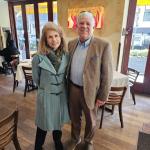Way out in the Mojave desert is a phone booth. Some years ago, a resident of LA published a picture, which inspired Godfrey Daniels to start calling the phone. He was prepared to keep calling for years until someone picked up.
A month later, Lorene Aiken, who worked at the cinder minds nearby, answered the phone and chatted with Daniels for a few minutes. Daniels took a pilgrimage to see the phone booth, and designed a web site in its honor.
“I thought that was about as far as it would go,” he said. “Next thing you know, I’d go to my P.O. box, and there would be clippings about the Mojave Phone Booth from newspapers in languages I didn’t know how to read. It just spread.” When he listed the number to the booth, the phone began to ring constantly, and the image of the lonely structure appeared in magazines and commercials all over the world.
The story of the Mojave phone booth is one of the stories told in Ariana Kelly’s forthcoming Phone Booth, a contribution to Bloomsbury’s “Object Lessons” series.
Phone booths appeared late in the nineteenth century, invented by William Gray of Hartford, Connecticut after a desperate nighttime search for a way to contact a doctor for his wife. A year after that night, “Gray had patented the first coin-operated pay phone, having entrusted George A. Long, a sixteen-year-old apprentice at the Pratt and Whitney factory, to engineer a working machine based upon his sketches. The design went through several iterations before it became more or less what we have today: an automated, prepay machine.”
The earliest phone booths were “acutely beautiful examples of craftsmanship: wooden, spacious, inset with carpet and cushions, as if to suggest, subliminally at least, the value we once placed on transitional spaces. These areas, which were neither here nor there, were in fact designed to help people get from here to there and readily lent themselves to moments when private life spilled into the public. A phone booth was not just a convenient place to have a conversation— it was a significant place.”
Kelly’s book examines the history and decline of phone booths, their re-use for everything from prayer to wifi, their importance in film and story. Her book never quite nails the significance of this object, but the detail of her anecdotes makes it delightful.
(Photo by Andrew Girdwood.)















